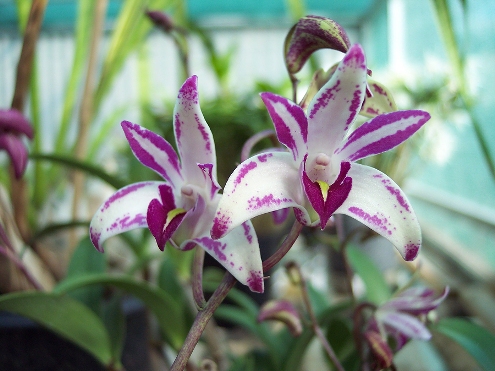
Think of your dendrobium as having two homes; the big one, which is either your house, garden or greenhouse, where the environment must be controlled to maintain a steady balance of humidity, air flow, lighting and temperature; and the smaller, more intimate one, which is the pot or container you choose to house your plant. There are a few things to consider when choosing this second home for your dendrobium. Luckily they are no harder to get your head around than ABC!
A – A Plant is Only as Healthy as its Growing Medium
Dendrobiums benefit the most from a porous, free-draining growing mixture. This allows the water to drain straight through the mixture, providing ample air flow to the roots. In their natural environment, dendrobiums grow on and around trees, drawing nutrients from fallen leaves and pieces of bark that decompose on the ground. This environment can easily be mimicked in your own home, as plenty of bark-based growing mixes are readily available. Bark is a tried and trusted staple of orchid growing, but there are other choices. Charcoal, lava rock and perlite can all be used successfully in different combinations, as well.
For stability, try adding some pieces of a heavier material, such as pebbles, to the bottom of the pot. Keep an eye on the growing medium before and after watering to make sure that it is draining properly. You should change the growing mix as soon as it begins breaking down. When the medium starts decomposing, it will retain more water.
B – Be Careful, but be Creative!
Dendrobiums need healthy roots to stay alive and should be handled with care during potting. Traditionally, dendrobiums are planted in pots that are small compared to the size of the plant. However, there is no reason why you shouldn’t allow yourself to be a little creative with your choice of pot. In fact, dendrobiums lend themselves particularly well to hanging pots and baskets, which are a great way of adding variety to your plant collection and decorating your home. Hanging baskets are available in many different shapes, sizes and materials.
Regardless of which type of container you choose to house your orchid, make sure that it allows for drainage and air flow. Traditional clay and ceramic pots are not very beneficial in this regard, as they tend to either restrict the airflow or provide insufficient drainage. If you insist on getting a clay pot, try potting the orchid in a plastic pot and placing it inside a larger clay pot.
Clear plastic pots have many practical advantages over their competitors, and they have recently become the container of choice for the American orchid grower. They are inexpensive and easy to add a few extra air holes or slits in the pot if needed. They also allow you to see what’s going on with the potting mix.
C – See the Problems Before They Seize your Plant
Say you’ve chosen the perfect pot, the perfect growing medium and the perfect place to put your dendrobium. How can you be sure that all these elements are indeed perfect, and that your orchid will agree with your opinion? The only way to make sure is to watch your plant carefully. But what do you have to watch for?
Keep a close eye on the roots of the plant. If they appear to be cramped or twisted, you may need to repot the orchid in a bigger pot. Healthy dendrobium roots should be white and firm with shiny, green tips. Browning or shriveled roots need to be trimmed as soon as you spot them. Watch for any irregularities in the growing medium, as well. Pale, sticky patches or discolorations are signs of infections, either from bacteria, fungus or mold. If your growing medium has attracted either of these, it is time to throw it out and replace it with a fresh batch. Treat the plant with fungicides or bactericides as appropriate and remove any infected pieces of plant tissue before repotting.
Although dendrobium orchids grow slowly and do not develop their roots as much as much as some of their cousins, every orchid will eventually outgrow its current pot. When the time comes to repot, you will be more than ready. As long as you remember your ABCs, you can handle the repotting with ease and look forward to another two or three years with your dendrobium before repeating the cycle again.
Mary Ann Berdak is the author of Dendrobium Orchid Care: The Ultimate Pocket Guide to Dendrobium Orchids, available at Amazon.com. For more information on orchid care, download her free report, “The 5 Biggest Orchid Mistakes (and How to Avoid Them!)”, at OrchidCareZone.com.
Related Articles & Free Email Newsletter
Light Reflections & Reflectors for Orchids



Comment here